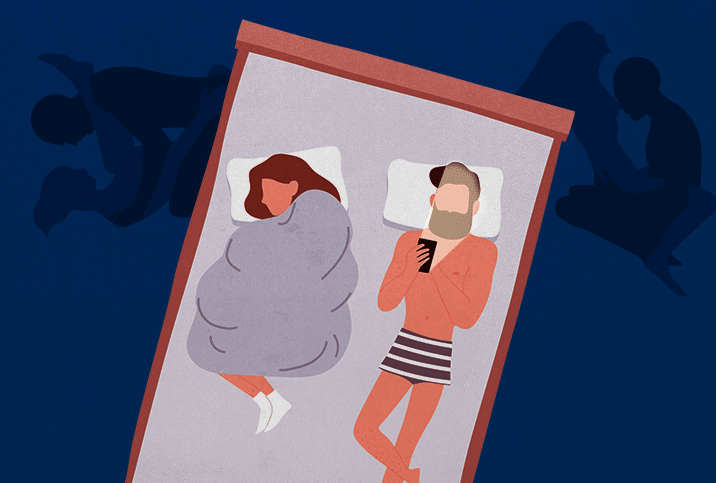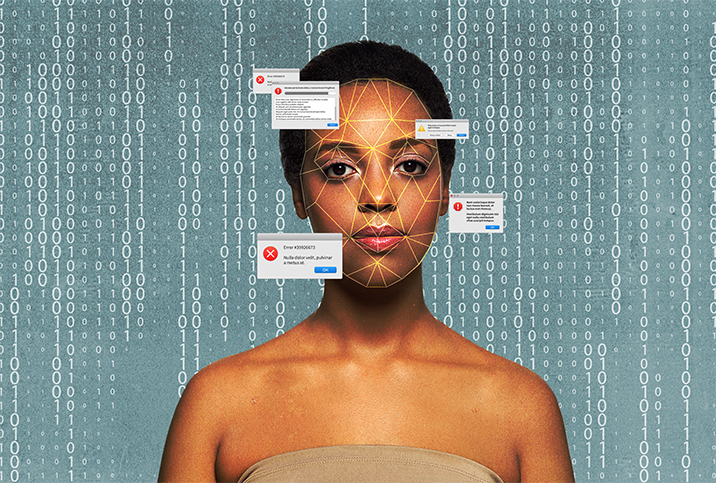A Brief History of Porn

The year was 1993: Bill Clinton had just been elected president, Tag Team's "Whoomp! (There It Is)" was climbing to the top of the charts, and the CD-ROM (compact disc read-only memory) had barely hit the market when a company called Interotica released the very first interactive porn CD-ROM. The adult game, called "Nightwatch Interactive," let players control a voyeuristic security guard who could navigate between TV monitors to peep on sexy scenes unfolding around the building.
In this early digital porn artifact, video quality was choppy and the interactivity was limited. But within a year of its release, "Nightwatch Interactive" had become one of the 10 best-selling CD-ROMS. A 1993 article from the Los Angeles Times noted that while the CD-ROM market was still in its infancy, pornographic discs such as "Nightwatch Interactive" were "selling like hot cakes."
"Nightwatch Interactive" came out at a time when "nobody knew what a CD-ROM [was] except for...nerdy computer men," as Interotica co-founder Lawrence Miller later explained to Gizmodo. CD-ROM porn may not have stood the test of time, but it's a shining example of how porn is frequently the hidden engine behind new technologies.
Brian M. Watson, historian and author of "Annals of Pornographie: How Porn Became Bad," said that porn is often among the first applications for a new art form or technological medium because its creators are forced to be resourceful.
"A lot of pornographers tend to be on the edges of society," Watson said. "So they're looking to make [porn] however they're able to. If that's VR, cool. If that's a VHS, cool. If that's a CD-ROM, cool. They're willing to experiment with new mediums, and the money pours into that new technology."
Porn: A quick definition
Pornography, Watson explained, is derived from the Greek porni ("prostitute") and graphein ("to write"). Originally used to describe art or literature depicting the life of prostitutes, the word "porn" today has evolved to include any material—images, words or movies—that is sexually explicit and intended to cause arousal.
Mention the word "porn" and most people are likely to think of hardcore movies. But the advent of film and the release of the first porn film didn't come until the late 19th century, at which point humans had been making pornography for thousands of years. In fact, the history of porn can be traced back 35,0000 years to the Upper Paleolithic period, which is where our timeline starts:
40,000 to 10,000 B.C.E.: The Venus statues
More than 20,000 years before we started using ceramic technology to make containers, tiles, bricks or anything utilitarian, humans were forming fired clay into sexually explicit figurines. These statuettes—which depict women with deliberately exaggerated vulva, breasts, butts and hips—are often called Venus figurines in a reference to the Roman goddess of beauty who they predate by thousands of years.
Around 200 Venus figurines have been discovered at Upper Paleolithic sites across Europe and parts of Asia, dating to between 40,000 BCE and 10,000 BCE (before common era). While there is much scholarly debate over what these figurines might have represented in the eyes of the artists and their ancient audiences, many historians interpret their well-endowed characteristics to be associated with fertility, sexuality and beauty.
3,500 to 3,000 B.C.E.: Sumerian erotic poetry
Many millennia after humans sculpted the first shapely statue, the ancient Sumerians of Mesopotamia developed the earliest known form of writing, called cuneiform. Wedge-shaped cuneiform symbols were carved on clay tablets to document temple activities, write stories and record erotic poetry exalting the sweetness of women's vulvas.
The oldest known erotic poem was written in cuneiform more than 4,000 years ago in the region now known as Iraq, and reads, "Bridegroom, let me caress you/My precious caress is more savory than honey/In the bedchamber, honey-filled/Let me enjoy your goodly beauty."
1524: 'I Modi' or 'The Sixteen Pleasures'
According to Watson, the modern history of Western pornography didn't kick off until the 15th century, when the invention of the printing press made it possible to distribute written and illustrated materials en masse to audiences of all socioeconomic levels and sexual preferences. By 1524, only decades after printing technology developed to include illustrations, humanity saw its first mass-produced book of porn. "I Modi" or "The Ways"—best known as "The Sixteen Pleasures"—is an illustrated sex guide based on paintings by Giulio Romano and published by Marcantonio Raimondi. Pope Clement VII ordered all copies of the book to be confiscated and destroyed, bewstowing it with the honor of being the first work of pornography to be banned by the Catholic Church.
Only decades after printing technology developed to include illustrations, humanity saw its first mass-produced book of pornography.
In 1527, the second edition of "I Modi" was published with sonnets by Pietro Aretino, an Italian author, poet and playwright who Watson called the "father of pornography." Aretino wrote 16 bawdy poems to accompany the illustrations of sexual acts in "I Modi," creating what Watson refers to as "the first Playboy magazine in all of history." (The pope banned this one, too.)
1749: 'Fanny Hill'
In the years that followed, titillating titles such as "La Puttana Errante" ("The Errant Prostitute"), circa 1650-1660, and "L'École des Filles" ("The Girls' School") in 1665 would help build literary techniques like dialogue and scene-setting that would pave the way for the novel—a format swiftly adopted for porn.
Indeed, not 30 years after "Robinson Crusoe," considered the first English novel, was published in 1719, came "Fanny Hill," considered the first pornographic novel. Written by John Cleland and published in two volumes in 1748 through 1749 as "Memoirs of a Woman of Pleasure," the book chronicles the life of a London prostitute and includes scenes of lesbianism, flagellation, group sex and male homosexuality—all colored with charming metaphors such as "nether mouth," a euphemism for vagina.
Watson named "Fanny Hill" as one of the most "surprising" pieces of pornography that he's encountered in his research.
"One of the things that really surprises me about early erotic writing is [that it's] told from the point of view of sex workers," he explained. "You might initially look at that and assume it was sexist, but really what some of these early works are trying to do is empower sex workers—which is a concept that's still new and alien to us."
The 1840s: Pornographic photography
Shortly after the daguerreotype, an early form of photography invented in 1839, pornographers laid claim to the new technological medium. The earliest pornographic daguerreotype is an 1846 exposure depicting a middle-aged man inserting his phallus into a middle-aged woman's vagina.
The French pioneered daguerreotyping and photography, and Paris became a center for erotic and obscene images, Watson wrote in his book. In 1848, only 13 dirty picture joints existed in Paris, but by 1860, that number had ballooned to more than 400.
The turn of the century: The porn film industry is born
Film technology was introduced by Frenchman Louis Le Prince and further developed by American inventor Thomas Edison. In 1888, Le Prince created what is now history's oldest surviving motion picture, "Roundhay Garden Scene." In 1894, Edison released the first vaguely erotic film, "Carmencita," which featured a Spanish dancer and was considered scandalous(ish) because you could see her underwear and legs.
Edison followed "Carmencita" with other vaguely erotic pieces, such as "Fatima's Coochie Dance" and "The May Irwin Kiss," the latter of which featured a Victorian couple kissing and was called "beastly" by influential American artist and critic John Sloan.
"Magnified to Gargantuan proportions and repeated three times over, it is absolutely disgusting," Sloan wrote of the kiss.
Increasingly naughty flicks, such as "Le Coucher de la Mariée" ("Bedtime for the Bride"), were released in the decade following Edison's works, paving the way in 1908 for what many regard as the first hardcore porn film: "A L'Ecu d'Or ou la Bonne Auberge." The pioneering porno, which Watson discussed on an episode of the Conan O'Brien talk show, features a maid caught pleasuring herself with a vacuum cleaner by a pair of newlyweds.
"It's fascinating to me that someone invented the vacuum cleaner in 1901, a few years after that, they invent the camera, and it's like a year after that, they're making a pornographic film with a vacuum cleaner," O'Brien remarked. (His timeline is a little off, but you get the idea.)
The 1920s: Stag films
By the roaring '20s, the porn film industry was booming. This was the era of the stag films, illegally made and exhibited shorts that seem mind-blowingly hardcore for the era. These silent, black-and-white movies ran for about five to 10 minutes, and depicted shaky scenes of quasi-random, blush-inducing sex acts—think anal, fisting, pussy shaving, and penetration with a plugged-in, turned-on light bulb…stuff like that. Stag films were shown at underground stag parties, where college frats and other masculine communal organizations would throw down to host screenings of these illicit hardcore flicks.
The 1960s and '70s: The golden age of porn
In a 1968 court case involving the Swedish movie "I Am Curious (Yellow)," the Supreme Court ruled that the sexual expression depicted in the film was protected by the First Amendment. With porn no longer illegal, stag films all but disappeared and were replaced by feature-length porn movies with increasingly involved narratives.
It was the "Golden Age of Porn," starting in the 1960s and thriving through the '70s. It was a time when "there was something exciting about pornography," as Norman Mailer remembered in the documentary "Inside Deep Throat." "It lived in some mid-world between crime and art. And it was adventurous."
Archetypal golden age movies were reviewed by critics such as Roger Ebert, directed by "serious" directors including Gerard Damiano for "Deep Throat," and starred off-Broadway performers and the occasional standout, such as Georgina Spelvin, the star of Damiano's film "The Devil in Miss Jones." Spelvin plays Justine Jones, a lonely woman who dies a virgin and lives out sexual fantasies in eternity.
Spelvin, a theater-trained actress whose real name is Chele Graham, said she stumbled into the gig by accident. She had visited the set to interview for a catering position when Damiano asked her to read the part of Miss Jones with an auditioning actor—before offering her the role.
"The experience was cathartic, to say the least," Spelvin said. "No stranger to sex [I had eagerly relinquished my virginity at age 16], the idea of being 'immortalized' on film was enticing."
The 1980s: Porn and the VCR
During the 1970s and '80s, two home video formats—VHS and Sony's Betamax tapes—fought for supremacy. In the battle of VHS vs. Betamax, the legend goes that the porn industry played a key role in the former's triumph, as Sony reportedly wouldn't allow pornographic content to be recorded in Betamax format.
Audiences were eager to get their hands on VCRs so they no longer had to dress up in trench coats to sneak into shady theaters.
Whether or not this bit of porn folklore is true, there's no denying that porn had a hand in putting VCRs into living rooms. By the '80s, smutty films made up more than half of all home video sales in the United States. Audiences were eager to get their hands on VCRs so they no longer had to dress up in trench coats to sneak into shady theaters.
Some of the same elements behind the rise of the VCR might have played a part in the expansion of cable TV—another technology that brought porn into our bedrooms. Cable TV permitted more risqué programming, which became one of the factors that convinced viewers to shell out for sometimes-steamy movie channels such as HBO and specifically adult channels, including Playboy, Spice and Pleasure.
The 1990s and beyond: Porn and the worldwide web
This brings us, at last, to what has been arguably the single most important thing to happen to porn. The advent of the Internet changed porn forever, bestowing us with cheap, anonymous, anytime access to a virtually endless repository of pornographic images and videos catering to every conceivable taste, fetish and fancy.
After much debate about the censoring of the Internet, the Supreme Court in 1997 struck down the Communications Decency Act—the government's first notable attempt to regulate pornographic material online—for violating the First Amendment's guarantee of free speech.
So what does the future hold for porn? Will hyper-realistic, VR experiences phase out real sex? Will robots replace sexual partners? Will the disturbing deepfake trend porn continue to grow widespread?
"Whatever new medium is available, pornographers will embrace it," Watson said.
But the future of porn isn't all deepfake porn and dissociation from reality, he predicted.
"Porn has become way more women-positive," he pointed out. "In earlier works, it would have been [seen as] a terrible thing [for porn] to center around a woman." Now, we are seeing more feminist erotic filmmakers and works that challenge the perception of female sexuality.
Watson noted that porn has become more inclusive, too. "It's become more queer-positive," he said. "Representations of trans and nonbinary people in pornography has become much more common."
He added that porn might be on its way to becoming more normalized thanks to platforms like OnlyFans and XConfessions. "It's become a lot more accepted in the sense that lots of 'ordinary people' are doing it," he said. "It seems like humans are happy to share their bodies no matter what, and it's getting harder to control."


















